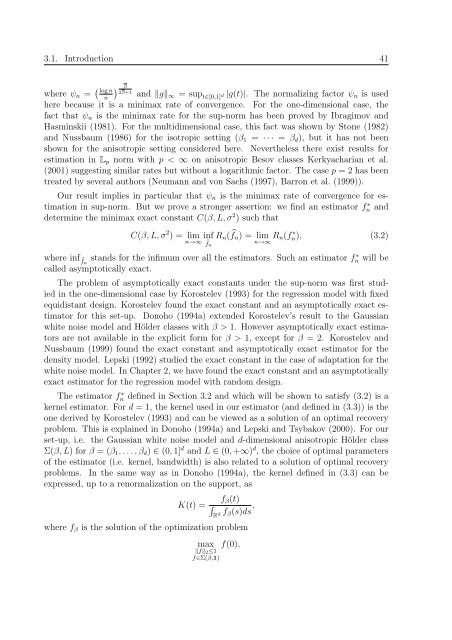THÈSE DE DOCTORAT DE L'UNIVERSITÉ PARIS 6 Spécialité ...
THÈSE DE DOCTORAT DE L'UNIVERSITÉ PARIS 6 Spécialité ...
THÈSE DE DOCTORAT DE L'UNIVERSITÉ PARIS 6 Spécialité ...
- No tags were found...
Create successful ePaper yourself
Turn your PDF publications into a flip-book with our unique Google optimized e-Paper software.
3.1. Introduction 41where ψ n = ( )log nβ2β+1and ‖g‖n∞ = sup t∈[0,1] d |g(t)|. The normalizing factor ψ n is usedhere because it is a minimax rate of convergence. For the one-dimensional case, thefact that ψ n is the minimax rate for the sup-norm has been proved by Ibragimov andHasminskii (1981). For the multidimensional case, this fact was shown by Stone (1982)and Nussbaum (1986) for the isotropic setting (β 1 = · · · = β d ), but it has not beenshown for the anisotropic setting considered here. Nevertheless there exist results forestimation in L p norm with p < ∞ on anisotropic Besov classes Kerkyacharian et al.(2001) suggesting similar rates but without a logarithmic factor. The case p = 2 has beentreated by several authors (Neumann and von Sachs (1997), Barron et al. (1999)).Our result implies in particular that ψ n is the minimax rate of convergence for estimationin sup-norm. But we prove a stronger assertion: we find an estimator f ∗ n anddetermine the minimax exact constant C(β, L, σ 2 ) such thatC(β, L, σ 2 ) = lim inf R n ( ̂f n ) = lim R n (f ∗n→∞ ̂f nn→∞n), (3.2)where inf ̂fnstands for the infimum over all the estimators. Such an estimator fn ∗ will becalled asymptotically exact.The problem of asymptotically exact constants under the sup-norm was first studiedin the one-dimensional case by Korostelev (1993) for the regression model with fixedequidistant design. Korostelev found the exact constant and an asymptotically exact estimatorfor this set-up. Donoho (1994a) extended Korostelev’s result to the Gaussianwhite noise model and Hölder classes with β > 1. However asymptotically exact estimatorsare not available in the explicit form for β > 1, except for β = 2. Korostelev andNussbaum (1999) found the exact constant and asymptotically exact estimator for thedensity model. Lepski (1992) studied the exact constant in the case of adaptation for thewhite noise model. In Chapter 2, we have found the exact constant and an asymptoticallyexact estimator for the regression model with random design.The estimator fn ∗ defined in Section 3.2 and which will be shown to satisfy (3.2) is akernel estimator. For d = 1, the kernel used in our estimator (and defined in (3.3)) is theone derived by Korostelev (1993) and can be viewed as a solution of an optimal recoveryproblem. This is explained in Donoho (1994a) and Lepski and Tsybakov (2000). For ourset-up, i.e. the Gaussian white noise model and d-dimensional anisotropic Hölder classΣ(β, L) for β = (β 1 , . . . , β d ) ∈ (0, 1] d and L ∈ (0, +∞) d , the choice of optimal parametersof the estimator (i.e. kernel, bandwidth) is also related to a solution of optimal recoveryproblems. In the same way as in Donoho (1994a), the kernel defined in (3.3) can beexpressed, up to a renormalization on the support, asK(t) =f β (t)∫R d f β (s)ds ,where f β is the solution of the optimization problemmax f(0),‖f‖ 2 ≤1f∈Σ(β,1)










